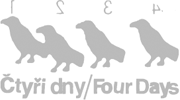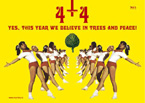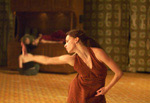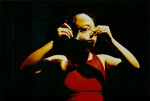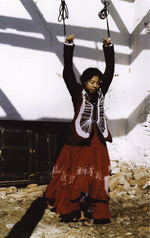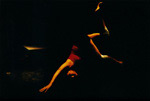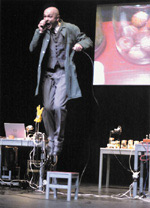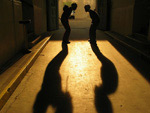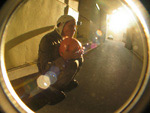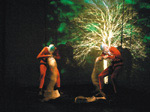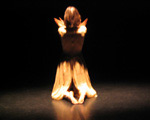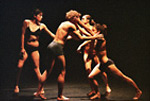
| ARCHIVE 2004 2005
| 2004
| 2003
| 2002
| 2001
| 2000
| 1999
| 1998
|
4+4 Days in Motion 9th Annual International
|
|
| CLUB GUY & RONI (Netherlands) The Language of walls This performance of Israeli choreographic
team Roni Haver &
Guy Weizman is the result
of an extended research of the female expression. It has
the atmosphere of a street exhibitions and skirmishes of
female gangs. Six dancers put the themes of virtuosity,
freedom, and sisterhood to the language of contemporary
dance into the devastating rhythm of live music of drums.
"Female Storm as grand final: Breathtaking, dramatic, still, enthusiastic and disturbing. Bonded female dynamics, free and yet within borders, full of energy. In a perfectly executed dance, a stunning and intoxicating feeling of life has been caught in a compact way." (Neue Presse)
Production: Grand-Theatre Groningen, www.grand-theatre.nl
Support of the Fonds voor Amateurkunst en Podium kunst, Gemeente en Provincie Groningen
|
|
| CRISTINA
MALDONADO "Fact" The aesthetics and philosophy of painter Francis Bacon were the inspiration for this long-term project. In this performance, absence is "unknown, as if the work becomes active through its strength". This close encounter of people, culture and thoughts has direct results.
Production: Four Days |
|
EDUARD GABIA (Romania) "Bonus" For several days, Eduard kept his eyes
shut. He experienced blindness, trying to discover the identity
of a new space. The performance "Bonus" is the
result of a reflexive attempt to comprehend the undefined
boundaries of the condition of the senses, the differences
between a sensation and an image, inner experience and visual
information.
|
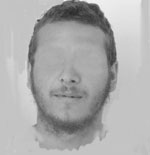 |
COMPAGNIE DRIFT (Switzerland) "Sound Machine" (theatrical concert) How does a fly scream when it bumps into
a burning-hot light bulb? What does Mr. Fish say to Ms Fish
when it asks for her fin in marriage? What does the rose
whisper when the sun comes up? What would we hear in the
garden at night if we our ears were more sensitive?
"... ingenious hilarity in the brilliant work by the internationally acclaimed trio from Zurich Company Drift, using dance, music, spoken word and multi-media, giving the audience an Ernie Kovacs look at our obsession with analyzing EVERYTHING, while masking the uncharted territory of our own neuroses. An evening of dance and theatre art to stay with you a lifetime." San Diego Live, San Diego, USA
Supported by: PRO HELVETIA
|
|
COMPAGNIE OLIVIER BODIN (France) "When" The multimedia performance of Olivier Bodin engages itself in body language and is based on the collective creations of dancers, musicians and video artists. It rises from the assumption that the human being is conscious of its own unique identity, its own current existence and deeds. And that the human body has a physical, organic and spiritual essence. For this reason, each of its manifestations provokes a series of questions: When does the body dance? And what does it mean? Where does the action begin and where does it end? Is a movement made right now connected to one made in the past and the future? Do we perceive time the same way?
In 1988,
Olivier Bodin graduated from the Centre
National de Danse Contemporaine in Angers, where
he also founded his own company. Here he created a total
of 19 choreographic works including the duet La
petite piece (1993), the street performance Les
Baltikans (1997), the "electric" solo 299
(1998), the trio about time entitled From
Time to Time (2002) and When
(2003).
Olivier Bodin's alchemy succeeds in breaking the barriers that normally prevail between an audience and the artists, the auditorium and the stage. Philippe Rubion, Courrier de l'Ouest
Co-productions: Carré, Scene nationale de Chateau-Gontier, Espace culturel Onyx de St Herblain, Agence de Développement Culturel de la vIlle de St Herblain, Ville de St Herblain
Supports: Centre Jean Vilar a Angers, Théatre de l'Hotel de Ville de St Barthélemy d'Anjou, Ville de Segré, Pays Haut-Anjou Segréen, Théatre de Saumur, Théatre de Thouars, Le CNDC d'Angers, M.J.C d'Avrillé, Centre National de la Danse a Pantin
|
|
TORNÁDO
LUE concert In 1993, the now defunct record label
Zoon Records produced
the company's debut album - a recording on a four-track
recorder. Together with Bez
ladu a skladu band, the group later became one of
the most respected alternative, Slovakian groups here in
the Czech Republic. The unusual use of Czech lyrics played
an important role in their songs - texts of Bohumil
Hrabal, Sylvie Plath translated by Jan
Zábrana.
|
|
KREPSKO (Česká republika) "Ada&Pter" An unexpected encounter of two ostensibly
incompatible principles - necessity and impossible assimilation.
Krepsko was founded in 2001 and since that time have been presented at the Alfred ve dvoře Theatre and the Roxy NoD Experimental space. They have repeatedly performed during the Four Days in Motion Festival, the Czech Dance Platform, the Theatre Flora Festival in Olomouc, and the Mimorial Festival in Kolín. They have presented their work in Hungary, Croatia, Germany, the USA and Canada.
The creative specifics of Krepsko Theatre consist of pure group improvisation that empties into an isolated expressive language and original performance structure. However, these prerequisites also apply in the creation of their unimprovised projects.
"A simultaneous composition with a sense of a delicate, reciprocated balance of collectives and individuals, great timing and sense of rhythm, anti-romantic images, twitches of civilization, absurdity, interjected poetics of film..., ...actors come and go, they have a common feeling for composition in the space, constantly introducing a fragile balance of couples, trios, groups, individual characters in the space". Nina Vangeli, Taneční zóna
|
|
VERONIKA ŠVÁBOVÁ (Czech Republic) "Mama Luna" Once again, a new day begins with things that need to be done. However, not before other tasks also appear. Another series of things to do. A solution exists that explores the widest variety of complicated rituals and the necessity to gain control over extreme disciplines. As well as courage and strength. It’s necessary to do so many things! All you need to do is get up and begin. In some situations in life, the survival of an ordinary day can become a war game where we need to find the courage to do even the most banal activities - when we get dressed, when we eat, when we leave home, when we speak to other people. Sometimes it’s necessary to overcome the fear of living. Living alone with us.
Veronika
Švábová (1974). She graduated in 1997 from the Duncan
Centre Dance Conservatory, then she spent one semester
at the Dance Academy of the
New York University in the United States. Currently,
she is completing her studies at the Department
of Dance Studies of HAMU in Prague. She has participated
at the projects of Simone Sandroni,
Jan Beneš, the Theatre na Voru, B. Látalová, just
to name a few. In 2001, Veronika created her own solo work
"Obsession"
which was presented at the
Alfred ve dvoře Theatre, the Duncan
Centre and also at the Ponec
Theatre during the Czech
Dance Platform. Since 2000, she has sailed with the
Forman Brothers and their production of "Purple
Sails (Nachové plachty)" on their theatre boat.
In 2003, she worked again with the Forman
Brothers Theatre where she choreographed the Philip
Glass's opera "La
Belle et la Bete (Kráska a zvíře)" at the National
Theatre in Prague. Her other work for the National
Theatre includes the choreography for Guiseppe
Verdi's opera "Requiem" that premiered
in March 2004. |
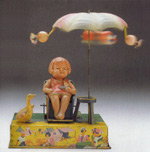 |
DIVADLO ANTENA (Czech Republic) "Garden" "We believe in pictures that should amuse and remain as thoughts of greater depths under the surface."
A theatre installation with elements of non-verbal theatre, visual art and multimedia. Two actors suspended in space above the stage use their bodies to tell a story of the world today, the mutual abstraction of people and the loss of values. On one hand, they create an uncertainty and uneasiness through their lack of understanding of new technology; yet on the other, they express their fascination for unknown perfection. These uncertainties and fascinations lead them to oblivion of fundamental needs and values, shifting the means of technology toward the horizon of absolute values, and toward the archetype of God. The performance uses video and slide projections, stage pictures and sound improvisations combined with Vectroscope images.
Antena Theatre was founded in 2001 by Czech mime, choreographer and dancer Petr Krušelnický and Danish actress and costume designer Helene Kvint. They concentrate on non-verbal and experimental multimedia projects, working with three fundamental parameters - sound, images, and the human body. Anténa creates theatre productions and performances, theatre installations, site-specific projects and art happenings. They have worked with choreographers in the Czech Republic and other European theatres (as well as with foreign artists and companies (Min Tanaka, Derevo, Antagon Theatre, Grotest Maro, Mezzo, etc.)
Supported by: Ministerstvo kultury ČR, Danish Actor Association, Motus o.s.
|
|
TWO FISH (Germany) "Triplicate" - Christiane Müller goes on research Members of the company Two Fish from Berlin are young artists whose creative approach is characterised by very personal questions: "Who is following me and what will he do to me? How do my opinions influence my relationships with other people? What kind of conflict will arise when someone changes my rhythm, or the way I perceive things? What kind of weapon should I use if I want to defend myself from this? And who will give it to me?" The artists have engaged themselves in these questions, and bring to the stage documentary material of their own experiences, relationships, and conversations, dance, their favourite music, plays and big secrets. Dancer/choreographer Angela Schubot and actor Martin Clausen created Two Fish in 2000, basing the name of the company on the same title given to their collaborative project. They have also created several other productions together, and are resident artists of the Podewil artistic centre in Berlin. Audiences and critics were fascinated by the apartment and stage version of the triptych about "Christiane Müller", engaged in authentic, irresistible experiences and enjoyment. The first part of the triptych was performed in a Berlin apartment located at "Gabriel-Max-Str. 2, 1 OG, Left", and the second part "Christiane Müller goes on research" was performed on an empty stage. Now, the third part continues with "Christiane Müller move" that will include both apartment and stage versions of the piece. The company is one of the latest discoveries of Berlin’s contemporary artistic scene.
"They speak about themselves - their histories, their worries, their interests - they dance, they gradually come together, their differences united by the common bond of daily human life. They might be us, we might be them. It is engaging stuff, performed with spirit and naturalness." Independent, 2003
Production: TANZTAGE BERLIN Supported by: Theater am Halleschen Ufer, Tanzfabrik Berlin
|
  |
FRANKFURTE KUCHE (Germany) inexhaustible (RW) The performance is a continuation of Thomas Plischke's 1998 solo piece "l'homme ASORTIR AVEC son corps". The general theme of both of these pieces is the "subversivity of the body" - more precisely, common mental abnormality, obsession and perversion. The creators were inspired by the texts of theatre visionary Antonin Artaud, the works of Thomas Harris, and ultimately the film of Ridley Scott's "Hannibal". The authors, Plischke and Kattrin Deufert, expose personal ties between Harris, writer of "Silence of the Lambs", "Hannibal" and "Red Dragon", and Antonin Artaud, a permanent patient of a psychiatric clinic.
Dr. Kattrin Deufert (1973) is a performer and a theoretician. She studied theatre, film, and media in schools in Frankfurt, London and Brussels. She has written her second doctorate on the theatre creations of John Cage. In 1990, she participated in performances based on Cage's score as a member of the Breakthrough company. She has worked on various musical-dramatic projects with Heiner Goebbels, Reinhild Hoffman and Manfred H. Wenniger. She has also worked as a program assistant of the Hessen radio station and was also employed at the Goethe Institut in Brussels. She currently writes about dance and multimedia and is the co-founder of the "Discursive Policlinic" in Berlin.
Thomas Plischke (1971) graduated from P.A.R.T.S. in Brussels in 1998, and from that time has been working as a choreographer and video artist. He received the Philip Morris Award for the "most outstanding performer" for his graduate work. His three solos, "Fleur (anemone)", "l'homme A SORTIR AVEC son corps" and "Demgegenüber Borniertheit", that he created in 1998 and 1999, and his duet with Erna Omarsdottir, entitled "how to embrace a horse" have been presented in many international festivals. During the Springdance Festival in 1999, he created another version of the cult-hit "Rites of Spring". It was because of this work that the BDC company originated, and for them, he created "Events for Television (again), (RE)SORT, Affects and Affects/Rework" during the period from 1999 to 2001. On the invitation of the Goethe-Instituut in Rio de Janeiro, he went to Brazil where he lived and in the slums of Rio. Here he created a score for the production "nao se pode falar" for the Cia Etnica De Danca company.
The group Frankfurte Kuche, conceived as a "temporary, autonomous zone", provides space and time for the analysis and research of artistic productions. In addition to Deufert and Plischke, Pirkko Husemann also creates with the company.
Production: Mouson Co-production:
BSBbis Brussels, Tanzquartier Vienna,
|
 |
MALA KLINE (Slovenia) "Campo de 'Fiori" The debut of the young Slovenian dancer/choreographer is inspired by the life and work of Renaissance magician, philosopher and scientist Giordano Bruno who was sentenced to death due to his public criticism of corruption and the decadence of religious and social institutions. The central theme of this meditative choreographic piece is the clash of the Old World with the New World, and the dramatic situation of a person in the middle of a complex labyrinth of tradition, of a human who moves toward the enlightenment of his own vision. Mala Kline began as a dancer in the Intakt Studio and in the Plesni Teatr in Ljubljana. Later she took part in ballet courses at the Ljubljana Conservatory. At the same time, she completed a series of workshops and dance courses in the framework of the Internationalle Tanzwoche in Vienna, conducted by such personalities as Joe Alegado, David Zambrano, Vera Mantero, Mark Tompkinson and Lloyd Newson. Mala was also fascinated by Tai chi, capoeira, and attended courses for future dance pedagogues. In 1995, she became a permanent member of the Iztok Kovacs company and participated in many choreographic works: Work in Preparation (1995), Chord and dart - first touch (1996), Principles of Cobra (1997), En-knap Open (1997), House of Liberty (1998). From 1999 to 2001, she worked with the Ultima Vez Dance Company in the production of As Much As Life is Borrowed. In 2001, she began teaching at dance schools and became a member of the Dancing Laboratory where she conducts research of the development of artistic creation and expression.
"...This is a thoughtfully structured solo dance piece with perfected execution, in which Mala Kline, using her extraordinary artistic power, presents physical self-revelation as the way that a dance subject exists. Simultaneously, her Renaissance reference patina closes the networking of meaningful pieces and reflections. This is thus a brave and mature work of an author, announcing reflective dance poetry, rendered meaningful by the author." Katja Praznik, Dnevnik 2004
Production:
Zavod EN-KNAP
|
|
COLLECT - IF (Slovenia) The project of seven performers from various dance and theatre companies (Rosas, Jan Fabre, Damaged Goods, Beton-Tanc, and Rebecca Murgi) originated on the basis of seven individual concepts. In the resulting creative process, the artists came together and worked on the piece as one script. The artists worked without any predetermined themes, roles, or aims. After two and a half months of their collective search, they found the basis of the piece in indecisiveness, ineffectiveness, inability of freedom and their own absence. The result is a remarkable stage shape moving on the confines of contemporary dance and theatre.
Collect-if is a project of the Slovenian production company Maska that also publishes an art magazine of the same name. The project was co-produced by Four Days (Prague) and art centres Troubleyn (Antwerp), Vooruit (Gent).
Supported by: Ministry of Culture of Republic Slovenia and City of Ljubljana, Slovenia
|
|
MARTINE PISANI (France) "Slow Down" "The gap comes from the feeling that you perfectly understand while you haven't understood it all." Gilles Clément
Six characters reveal secrets and obstacles of a public performance during a stage séance, outlining what it means, "to be on the stage". Their hesitation, lost orientation, inarticulate declarations, and even sophisticated movement sequences in a "non-dance" style, discretely find irony in the everyday demands of discipline, creativity, concentration and ardour. Pisani's creation is associated with the legacy of a group of American experimenters of the Judson Church Theatre, who searched for inspiration in ordinary human movement, everyday activities and who also discovered poetry in city exteriors.
Hushed sensitivity in "Slow Down" "...Other worlds come to mind: Charlie Chaplin's, George Appaix's, or Jaques Tati's. There is a great deal of humour but this isn't a farce. While the show still hasn't entirely found its own rhythm - since the truly comical must be free of snags - it nevertheless wins over the audience without being intrusive. Not intrusive enough." Liberation, 2002.
Produced by La compagnie du solitaire Co-oproduced by: Dieppe Scene Nationale, Le Vivat d'Armentieres Supported: Direction Régionale des Affaires Culturelles d'Ile de France - Ministere de la Culture et de la Communication and from ADAMI
|
|
GOHATTO (Italy) "progetto GDA" The character of Joan of Arc was the material for this project, that is homage to the strength and the fragility of women. The story is by all means not retold; however, it is perhaps dedicated to the mystic, ecstatic and physical aspects of this particular legend. The project correlates dance, video projections, live music, and ambient sounds to the conceptual stage installation that attempts to arrest the truth of fragility, vulnerability and "unknown" state of the human body.
Anna Albertarelli (1965) studied psychology and art history at the University in Bologna. She has been pursuing dance and martial arts, and since 1987, has focused her work on contact improvisation. She studied at the TanzFabrik in Berlin where she directed the projects Duel, First Angel, and La Custode. In Italy, she worked with Monica Francia, and in 1994 she created the Amadossalto company with Catia Dalla Muta. Members of this company included performers, musicians and video artists. Since 1998, she has been conducting research on contact dance for the handicapped. Since 2002, she has been one of the co-ordinators of the "Centre of Choreographic Research" in Bologna along with other Italian choreographers, musicians and performers.
Roberto Passutti (1970) is a director and composer who concentrates on multimedia arts. He works as a director, cameraman, sound engineer, window dresser and lighting designer. He has led research on the theme "modelling sound and sound and music sculpture". He has performed as a dancer with Anna Albertarelli. Several of his films have been projected in international film festivals. He also composes film music.
|
 |
ALINE NARI (Italy) "Air Suite" Tuesday 25.5. - 6:30 p.m. ATTENTION !!! Venue: Univerzální prostor NOD, Dlouhá 33, Praha 1
Aline Nari - started her career as a dancer/performer in famous theatres Teatro Carlo Felice di Genova and Teatro Regio di Torino. In 1997 she was a member of Compagnia Sosta Palmizi and participated in the projects of Raffaella Giordano and Giorgi Rossi. Since 2000 she has created her solo works.
Production: Teatri di Vita
|
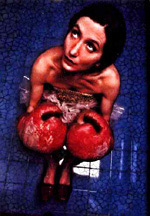 |
ANDREA ADRIATICO (Italy) "Anarchie" (film, 11 min) Tuesday 25.5. - 9:00 p.m. - Stromovka ANARCHIE (2000) was the first short film by the theatre director Andrea Adriatico. Two soldiers face one infront of the other, speaking about sex, anarchy and the loss of freedom. After "Anarchie", Adriatico created other short and feature films like "Pugni" (invited at Venice Film Festival) and "Il vento di sera" (invited at the Berlinale).
Production: Teatri di Vita
|
|
